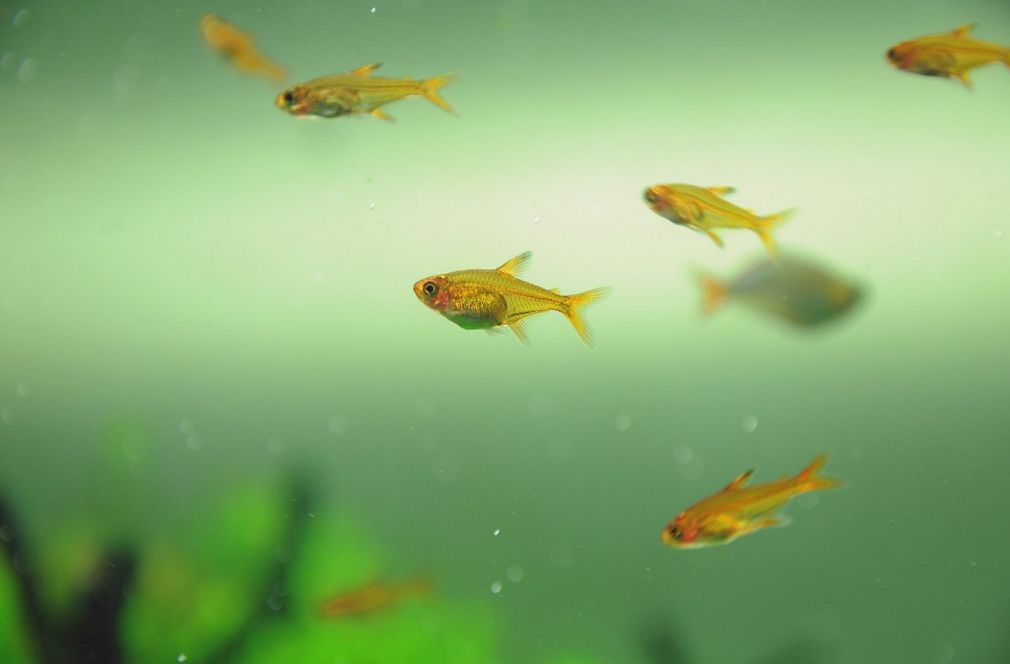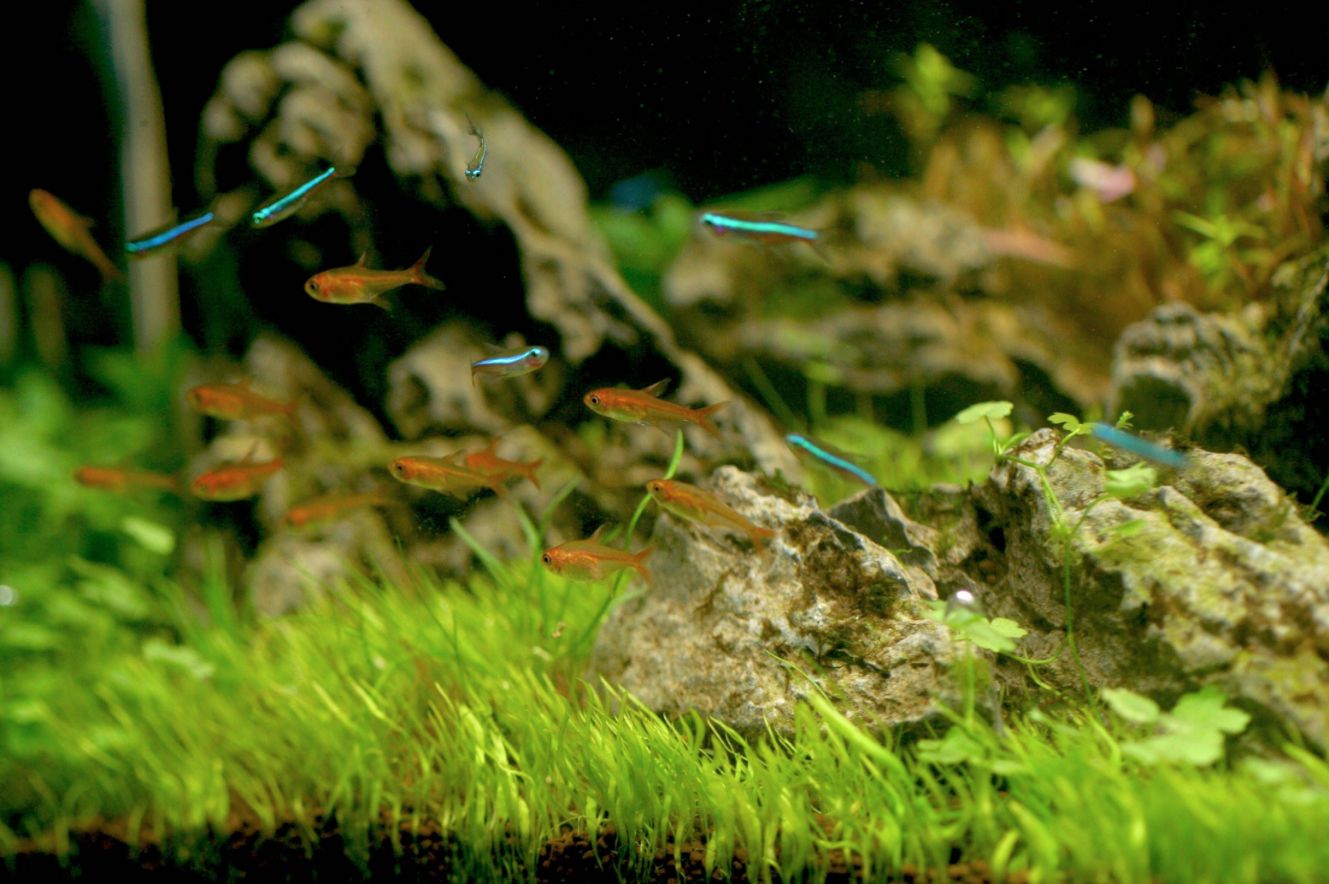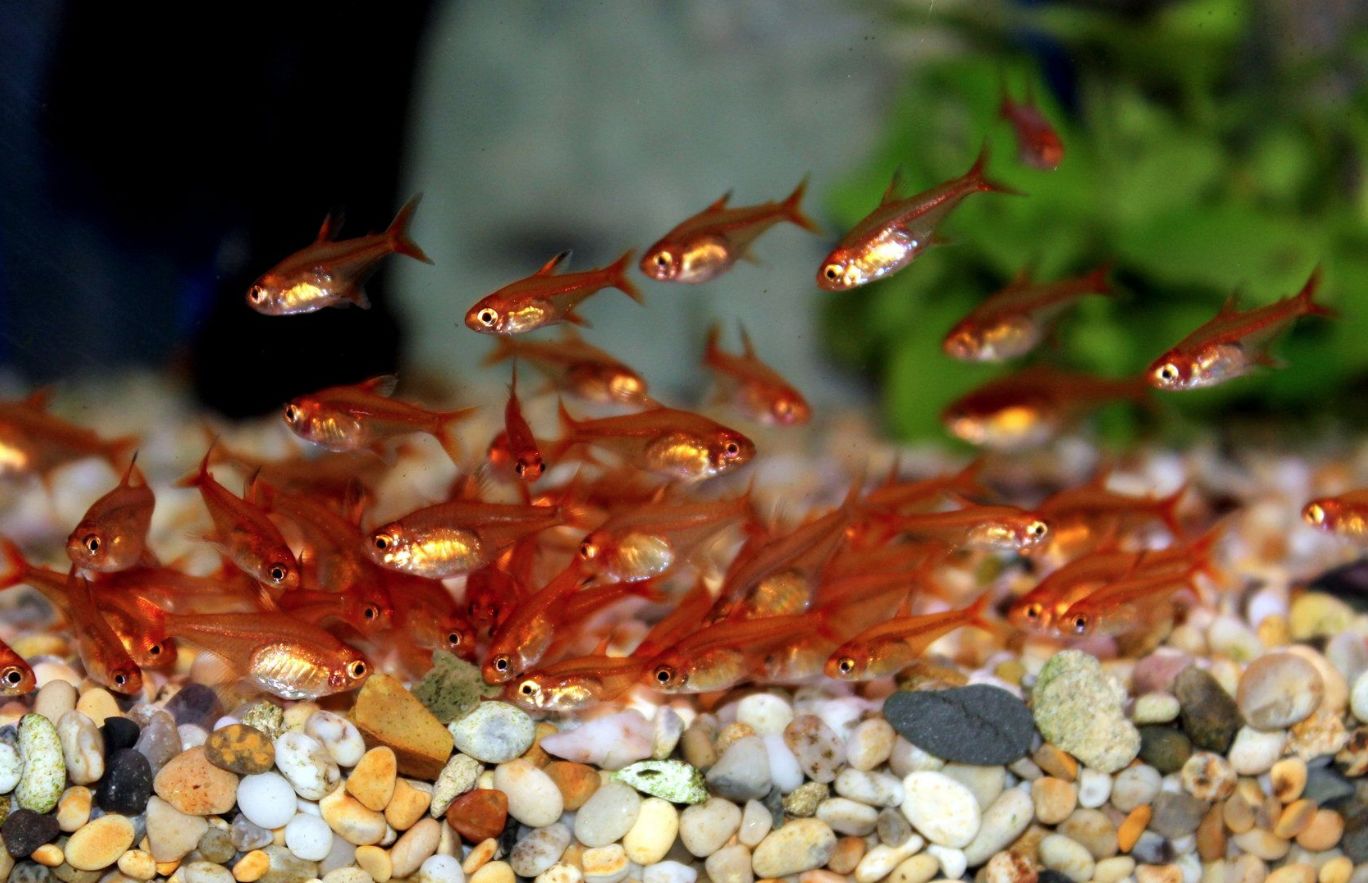The ember tetra is one of the smallest tetra species commonly kept in aquariums, making it a fantastic choice for nano tanks. With its vibrant coloration and peaceful demeanor, the ember tetra has gained popularity among both novice and seasoned aquarists.
Ember tetras are social creatures that do best in groups of six or more, which helps to reduce stress and encourage natural behaviors. When kept with compatible species, such as small rasboras or dwarf shrimp, they create a lively and colorful community tank.

Contents
Habitat in the wild
The ember tetra is one of the smallest tetra species commonly kept in aquariums, making it a fantastic choice for nano tanks. Belonging to the family Characidae, also known as the characins or characids, ember tetras have gained popularity among both novice and seasoned aquarists. The Characidae family is diverse, containing over 1,500 recognized species, including well-known members like neon tetras, black skirt tetras, and serpae tetras.
These fish are generally hardy and adaptable, thriving in a variety of tank conditions. They prefer a well-planted aquarium with gentle filtration that mimics their natural habitat in slow-moving waters. Specifically, ember tetras inhabit the Araguaia River basin in Brazil, particularly in its tributary, the Rio das Mortes. Discovered in 1986 by Heiko Bleher, a prominent figure in aquarium husbandry, the ember tetra was first described in 1987 and named after Bleher’s mother, Amanda, who was also a researcher.
In their natural environment, ember tetras are typically found in slow waters of forested streams and tributaries, where they inhabit areas rich in vegetation. The water conditions in the Araguaia River basin are characterized by low pH values, soft and slightly acidic water with a pH range of 5.0 to 7.0, and temperatures ranging from 72 to 82°F (22 to 28°C). The waters often have a light yellow-brown tint due to tannins released from decaying organic matter, and the bottom is usually covered with fallen leaves and branches, creating a rich habitat for these small fish.
Description
The ember tetra is a captivating addition to any aquarium, renowned for its striking appearance and petite size. These small fish typically grow to about 2 cm (0.8 in) in length, making them one of the smaller species within the tetra family. Their dominant coloration is a fiery red or orange, which can intensify with proper care, diet, and optimal environmental conditions. A well-maintained ember tetra showcases vibrant hues that catch the eye and add a lively splash of color to any setup.
Ember tetras have an average lifespan of 2 to 3 years, but with exceptional care and ideal conditions, some individuals may live slightly longer. Factors such as water quality, diet, and overall tank maintenance can significantly impact their longevity. A healthy ember tetra will not only display brilliant coloration but also exhibit active and lively behavior, making them a delightful addition to community tanks.
| Characteristic | Description |
|---|---|
| Scientific Name | Hyphessobrycon amandae |
| Common Names | Ember Tetra, amber tetra, orange tetra |
| Adult Size | Approximately 0.8 to 1 inch (2-2.5 cm) |
| Lifespan | 2-3 years (with proper care) |
| Body Shape | Slender and streamlined |
| Coloration | Vibrant fiery red or orange, intensifies when healthy |
| Black Patch | Near the base of the tail |
| Temperament | Peaceful and social |
| Preferred pH | 6.0-7.0 |
| Water Hardness | Soft to moderately hard |
| Temperature Range | 72-82°F (22-28°C) |
| Habitat | Slow-moving freshwater streams and rivers in Brazil, South America |
| Natural Behavior | Shoaling fish, social and active in groups |
| Diet | Omnivorous, accepts high-quality flake/pellet food, supplemented with live/frozen foods |
| Compatibility | Peaceful, suitable for community aquariums |
| Breeding | Relatively easy, scatter adhesive eggs among fine-leaved plants or spawning mop |
| Special Considerations | Provide suitable hiding spots and plant cover, replicate natural blackwater conditions |
Keeping in a tank
Tank Size
The small size of ember tetras allows them to dwell even in nano tanks; however, it is not recommended to keep them in tanks smaller than 10 gallons (37 liters). A larger tank provides more stable water conditions and ample swimming space for the fish, which is essential for their well-being. It also allows for more plantings and hiding spots that mimic their natural habitat, creating a more enriched environment. Since ember tetras are social creatures, it’s best to keep a group of six or more to promote natural behaviors and reduce stress. Therefore, consider the number of tetras you plan to keep when determining the appropriate tank size.
Tank Decor
Ember tetras thrive in densely planted aquariums. A small aquascape or nature aquarium works well for them, incorporating live aquatic plants such as Java Moss, Java Fern, Anubias, or Amazon Sword. These plants provide cover, oxygenate the water, and create a natural and comfortable environment. Floating plants like Amazon frogbit or water lettuce can help diffuse light and create shaded areas in the tank, making the fish feel safe and contributing to the development of their vibrant colors.
To further enhance their environment, provide subdued lighting, which can be achieved by placing taller plants, driftwood, or other decorations strategically to block direct light. Although tank decorations are not crucial, ember tetras exhibit their best coloration in well-decorated tanks with a dark substrate. A soft, sandy bottom closely resembles their natural biotope, and adding dry leaves can simulate their habitat, although they will darken the water.
Incorporate natural elements such as dried leaves, seed pods (like Indian Almond Leaves or Catappa Leaves), or botanicals such as alder cones to mimic the blackwater conditions of their native habitat. These additions provide extra hiding spots and foraging opportunities. Driftwood or rocks can also offer shelter and create visual interest in the tank, allowing ember tetras to explore and establish territories.
Water Parameters
For optimal health, ember tetras thrive in soft, acidic water. Although they can adapt to various water parameters, the recommended temperature range is between 72-82°F (22-28°C). The ideal pH range for ember tetras is around 6.0-7.0. They are adaptable to a wide range of water hardness levels, ideally maintaining between 4-12 dGH (degrees of General Hardness).
Ember tetras are sensitive to ammonia and nitrite levels; thus, it is crucial to keep these at zero. Regular monitoring of water parameters and performing routine water changes will help maintain good water quality. Additionally, water filtration should be gentle, as ember tetras are native to slow-moving waters and do not thrive in strong currents.
Diet
Ember tetras are omnivorous but have small mouths, so small-grained food is preferable. In the wild, they feed on small insects and zooplankton, while in an aquarium, they readily accept high-quality commercial fish foods such as flakes or pellets formulated for tropical fish. Look for a reputable brand that provides balanced nutrition.
To ensure a varied diet and promote optimal health and coloration, supplement their diet with live or frozen foods. Options like brine shrimp, daphnia, or small bloodworms can enhance their diet and encourage vibrant colors.

Tank mates
Ember tetra is a very peaceful fish, it won’t compete neither with other fishes nor with small shrimps as well (like cherry shrimp, for example). Tiny size of the adult fish also means that it won’t hurt even a new born shrimp.
It’d be perfect to keep the fish with other even-tempered fishes of South America and South-East Asia – such as neon tetra, honey gourami, pygmy corydoras and oto. This is a schooling fish, usually there are 8-10 species in a school. That’s why it is recommended to get exactly this number of tetra fish, to make them feel and behave more confident as well as demonstrate their natural habits.
Ember tetra is always in its school, they always swim in a flock and it is almost impossible to scatter them, because they feel more comfortable in a company of its kind. The fish swims mainly in the bottom part of the tank. At that if the fish lives together with other small fishes, they are active and swim around all the tank volume.
However, if there is just a school of this fish in a tank, they tend to spent most of the time at one place. Ember tetra will be a good companion for a shy celestial pearl danio.
Here are some popular tank mates that can be suitable companions for ember tetras:
- Harlequin Rasboras (Trigonostigma heteromorpha)
- Neon Tetras (Paracheirodon innesi)
- Glowlight Tetras (Hemigrammus erythrozonus)
- Black Neon Tetras (Hyphessobrycon herbertaxelrodi)
- Cardinal Tetras (Paracheirodon axelrodi)
- Rummy Nose Tetras (Hemigrammus rhodostomus)
- Dwarf Gouramis (Trichogaster lalius or Trichogaster chuna)
- Sparkling Gouramis (Trichopsis pumila)
- Celestial Pearl Danios (Danio margaritatus)
- White Cloud Mountain Minnows (Tanichthys albonubes)
- Dwarf Rasboras (Boraras spp.)
- Endler’s Livebearers (Poecilia wingei)
- Guppies (Poecilia reticulata)
- Platies (Xiphophorus spp.)
- Corydoras Catfish (Corydoras spp. – pygmy cory, panda cory, adolfoi catfish)
- Otocinclus Catfish (Otocinclus spp.)
- Bristlenose Plecos (Ancistrus spp.)

Gender differences: male vs female
There is no distinct color differentiation between male and female ember tetras; both sexes showcase the same vibrant fiery red or orange hues, which can vary in intensity based on health and environmental conditions. However, adult females typically exhibit a more rounded and fuller abdomen compared to males, especially when they are ready to spawn. This rounded shape is due to the presence of eggs, making females appear visibly thicker.
Another key differentiating feature is the air bladder. In females, the air bladder is more prominent and easily visible through their nearly transparent bodies, contributing to their rounded appearance. The male’s air bladder, in contrast, is smaller, more pointed, and often has an irregular shape. This difference can be subtle, but with careful observation, it becomes noticeable.
Additionally, males tend to display more active and assertive behavior, especially during mating rituals. They often engage in more pronounced swimming displays and may chase females to entice them to spawn. The social dynamics between males and females also play a role in the aquarium environment, as having a mix of both sexes can lead to more natural behaviors and interactions.

Breeding
Breeding ember tetras is relatively straightforward and closely resembles the breeding practices of other species within the Hyphessobrycon genus. For those looking to raise a significant number of juveniles, it’s advisable to set up a separate spawning tank.
Spawning Tank Setup
A tank measuring approximately 30 x 20 x 20 cm is suitable for breeding. This tank should feature dim lighting and be equipped with dense plant cover, such as Java moss or other fine-leaved plants, which serve as spawning substrates. It’s essential to create an environment that mimics their natural habitat.
Water Parameters:
- pH: 5.0 – 7.0
- General Hardness (GH): 1 – 5
- Temperature: 27 – 29 °C
Using soft, low-hardness water is critical, and filtration through peat can help achieve optimal water conditions. Osmotic water can also be beneficial for breeding. A small airlifting filter is ideal for maintaining gentle water flow while providing adequate filtration.
Spawning Behavior
Ember tetras can spawn in groups, ideally with about five individuals of each gender, making it an exciting process to observe. They may also spawn in pairs. To encourage spawning, it’s recommended to keep males and females in separate tanks prior to breeding.
When females are visibly carrying eggs (indicated by a rounded abdomen) and males display their brightest colors, it’s time to introduce them to the spawning tank. Select the plumper females and the most vibrant males, and transfer them in the evening.
Spawning Process
Typically, spawning occurs the following morning. It’s crucial to remove adult fish from the spawning tank immediately after spawning, as they may eat the eggs if given the opportunity. The eggs will incubate for approximately 24 to 36 hours before hatching, and the fry will begin swimming within 3 to 4 days post-hatching.
Raising the Fry
Once the fry start swimming, they can be fed with finely crushed flakes or specialized fry food. It’s important to maintain excellent water quality and provide gentle filtration to ensure the young fish thrive as they grow. With proper care, the juveniles will flourish, adding vibrancy to your aquarium.